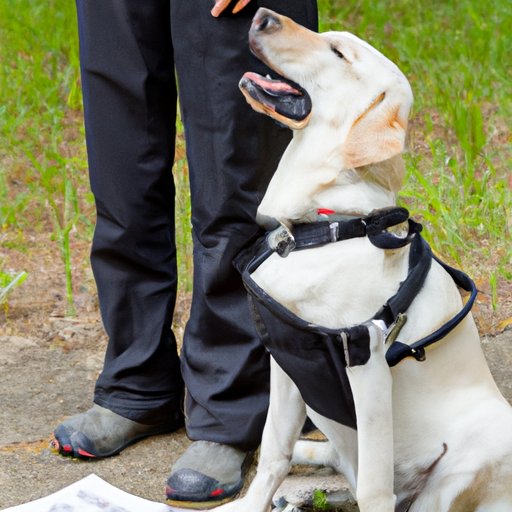Introduction
Service dogs are specially trained animals that provide assistance to people with physical or mental disabilities. They can help their owners in a variety of ways, from providing emotional support to performing physical tasks. Training a service dog requires patience, consistency, and dedication, as it can take several months or even years to teach all the necessary skills.

Researching Requirements and Regulations for Service Dog Training
Before you begin training your dog, it’s important to research the laws and regulations in your area. Depending on where you live, there may be specific requirements for service dog certification. For example, some states require that the dog receive specialized training from a certified professional before they can be considered a service animal.
It’s also important to familiarize yourself with the Americans with Disabilities Act (ADA). This federal law outlines the rights of individuals who use service animals. Knowing the rules and regulations in your area will help you ensure that your service dog meets all the necessary criteria.
Assessing Temperament of the Dog
When selecting a dog for service work, it’s important to consider their temperament. A service dog should be confident and relaxed in a variety of situations. It’s also important to look for signs of aggression or fear, as these traits can make it difficult for the dog to perform their duties.
In addition to assessing temperament, you should also consider the physical traits of the dog. Certain breeds have traits that make them more suitable for service work, such as intelligence, trainability, and strength. Research different breeds to find one that best fits the needs of your particular situation.

Creating a Comprehensive Training Plan
Once you’ve selected a suitable dog, it’s time to create a comprehensive training plan. Start by establishing clear goals and timeline for training. This will help you stay focused and motivated during the process.
You should also identify resources to help you with training. Working with a professional trainer can be beneficial, as they can provide guidance and advice throughout the process. There are also books, videos, and online courses available to help you learn the basics of service dog training.
Teaching Basic Obedience Commands
The first step in training a service dog is teaching basic obedience commands. This includes commands like “sit”, “down”, “stay”, and “come”. It’s important to demonstrate each command correctly and reward your dog for following instructions.
Positive reinforcement is an important part of training, as it encourages your dog to continue following commands. Offer treats or verbal praise when your dog follows instructions correctly. This will help build a positive association between the command and the desired behavior.

Training the Dog to Respond to Specific Tasks
Once your dog has mastered basic obedience commands, it’s time to start training them to respond to specific tasks. This could include helping someone get dressed, opening doors, or retrieving objects. When introducing a new task, it’s important to break it down into small steps and reward progress.
For example, if you’re teaching your dog to open a door, start by rewarding them for touching the doorknob. Once they’ve mastered this step, reward them for turning the knob. Gradually increase the difficulty of the task until your dog is able to open the door on command.
Practicing Regularly
In order for your dog to retain the skills they’ve learned, it’s important to practice regularly. Schedule regular practice sessions to reinforce the commands and tasks you’ve taught them. This will help your dog stay focused and motivated.
As you practice, pay attention to your dog’s behavior and make adjustments to the plan as needed. If your dog is having trouble with a certain command or task, take a step back and break it down into smaller steps. Consistency is key when it comes to training a service dog.
Conclusion
Training a service dog is no easy task, but with patience and dedication it can be done. Start by researching the laws and regulations in your area. Then assess the temperament of the dog and create a comprehensive training plan. Teach basic obedience commands and introduce specific tasks slowly. Finally, practice regularly and make adjustments to the plan as needed.
If you’re feeling overwhelmed by the process, seek professional help. A certified trainer can provide guidance and advice to help you successfully train your service dog.
(Note: Is this article not meeting your expectations? Do you have knowledge or insights to share? Unlock new opportunities and expand your reach by joining our authors team. Click Registration to join us and share your expertise with our readers.)
